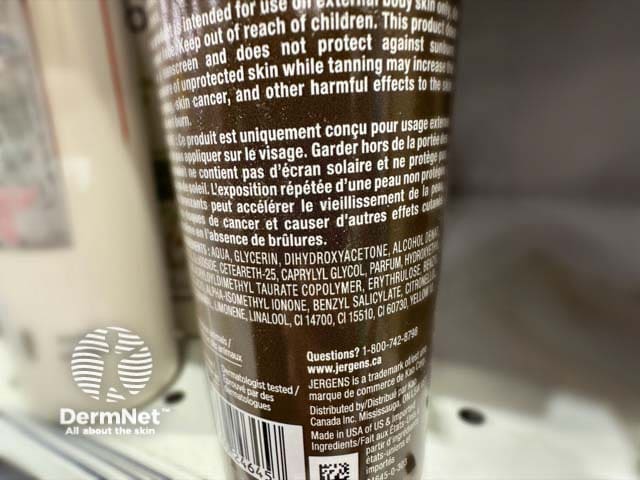Main menu
Common skin conditions

NEWS
Join DermNet PRO
Read more
Quick links
Author(s): Caden Carver, Arizona College of Osteopathic Medicine, Midwestern University, Glendale, Arizona, United States
Previous contributor(s): Vanessa Ngan, Staff Writer (2002)
Reviewing dermatologist: Dr Ian Coulson
Edited by the DermNet content department
Introduction - fake tan
Introduction
How it works
Formulations
Demographics
How to use
Efficacy
Precautions
Side effects
Dihydroxyacetone (DHA) is a ketotriose monosaccharide commonly used as the active ingredient in sunless tanning agents (fake tan). DHA is synonymous with glycerone or 1,3-dihydroxypropan-2-one.

A sunless tanning product containing dihydroxyacetone (DHA)
DHA was originally used as an artificial sweetener for diabetic patients. In the 1950s, it was also used orally for children with glycogen storage diseases, when it was discovered that it induced a brown pigmentation to the skin.
Currently, DHA is the only FDA-approved agent for sunless tanning. It has also been used in vitiligo to temporarily induce pigmentation in affected areas.
DHA is a three-carbon sugar that functions as part of the natural glycolysis pathway. It can be synthetically produced when Gluconobacter oxydans ferments glycerol, or through electrocatalytic oxidation.
DHA is thought to penetrate the stratum corneum when applied topically, where it undergoes a Maillard reaction (non-enzymatic glycation) with free amino acids such as glycine, alanine, leucine, and valine. The product of this reaction are melanoidins, which are large, pigmented nitrogenous structures resembling melanin, producing a darkening effect in the skin.
Although considered safe for most people, some should take caution when using DHA.
Dihydroxyacetone is available in numerous forms, given its compatibility with water and oil-based solutions.
The DHA concentration in each formulation determines the resulting degree of tan. Concentrations range from 1–15%, most commonly 4–8%.
In most cases, changes in pigmentation begin around one hour after topical application and are most prominent after 8–24 hours. Duration of pigmentation changes normally range from three to ten days. The required number and frequency of applications to maintain desired pigmentation changes varies based on bodily location. Areas with thinner skin require more frequent application of DHA compared to thicker skin.
More recently, microencapsulated formulations of DHA encourage slow release of active molecules, providing a longer-lasting tan as well as increasing product shelf-life.
It is unknown whether DHA penetrates deeper than the stratum corneum, which is more likely in the setting of a compromised epithelial barrier and may lead to adverse effects. DHA may also contribute to skin dryness, irritation, and Contact dermatitis when applied excessively or in those with sensitivities to ingredients in sunless tanners.
The Maillard reaction induced by DHA can generate free radicals such as reactive oxygen species, resulting in damage to collagen, elastin, and DNA in cells. This may contribute to Skin ageing and the appearance of wrinkles. Free radical generation is increased when DHA is used in combination with UV exposure. DHA may also limit the natural production of vitamin D after sunlight exposure.
The disadvantages and adverse effects associated with topical DHA use may be limited by using concentrations 10%, adding antioxidants to DHA formulations, and combining DHA with barrier-protecting agents and natural fragrances. Newer technologies including oxidant-free electrocatalytic oxidation may mitigate adverse effects of free radical damage.
DHA has also been demonstrated to cause respiratory tract and eye irritation if inhaled or contacting mucosal surfaces.
DHA self-tanner is not a replacement for sun protection and it is still important to use sunscreens and sun protective clothing for ultraviolet protection.
Approved datasheets are the official source of information for medicines, including approved uses, doses, and safety information. Check the individual datasheet in your country for information about medicines.
We suggest you refer to your national drug approval agency such as the Australian Therapeutic Goods Administration (TGA), US Food and Drug Administration (FDA), UK Medicines and Healthcare products regulatory agency (MHRA) / emc, and NZ Medsafe, or a national or state-approved formulary eg, the New Zealand Formulary (NZF) and New Zealand Formulary for Children (NZFC) and the British National Formulary (BNF) and British National Formulary for Children (BNFC).